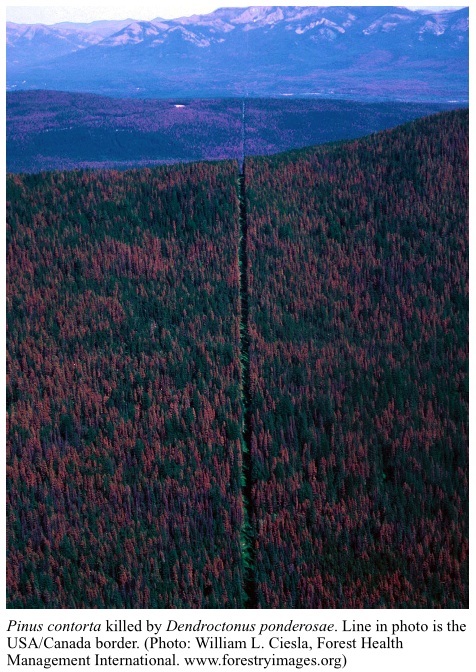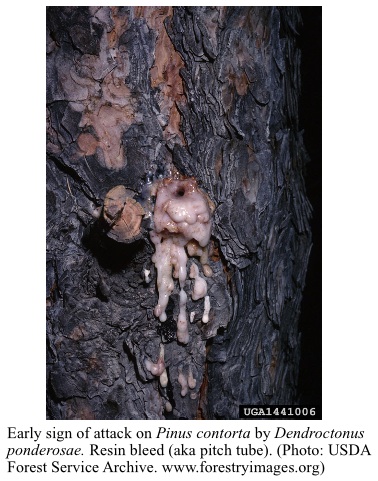PESTS AND DISEASES OF FORESTRY IN NEW ZEALAND
Unwanted bark beetles in New Zealand
Scion is the leading provider of forest-related knowledge in New Zealand
Formerly known as the Forest Research Institute, Scion has been a leader in research relating to forest health for over 50 years. The Rotorua-based Crown Research Institute continues to provide science that will protect all forests from damage caused by insect pests, pathogens and weeds. The information presented below arises from these research activities.
From Forest Health News 154, August 2005.
Bark beetles in the genera Dendroctonus and Ips (Curculionidae: Scolytinae) are generally considered to be the most serious insect pests of coniferous forests in the Northern Hemisphere; many species are capable of attacking and killing healthy trees. There are about 20 species of Dendroctonus — two species are native to Europe/Asia, and the remainder are found in North America. There are about 65 species of Ips including 26 species in North America.
Species of Dendroctonus are generally far more aggressive than Ips spp. Most Dendroctonus spp. breed only in standing trees and all of them, with one possible exception, are capable of killing healthy vigorous trees. As far as it is known all species of Dendroctonus are associated with symbiotic fungi that modify host physiology and accelerate the rate with which host resistance to attack can be overcome.
Most species of Ips breed in slash or in broken, fallen, or dying trees but some species, under favourable conditions and when numbers are great enough, are capable of making successful primary attacks on healthy trees.
 There has been an outbreak of Dendroctonus ponderosae in British Columbia going on for several years now. In 2002 alone the beetle infested over 785,000 hectares of Pinus contorta and killed over 70 million cubic metres of trees. The cost to the economy of British Columbia is reckoned in billions of dollars. Dendroctonus and Ips spp. are common interceptions at New Zealand ports. In the period 1952–90 four species of Dendroctonus and 17 species of Ips were found in wood packing material, dunnage logs, etc., imported into New Zealand. These comprised 191 interceptions. About one-third of the insects were alive when intercepted (Ensis BUGS Interception Database). However, the likelihood of detection of the life stages by visual inspection of the host material on importation is high if the bark is removed during examination, and the use of kiln-dried wood or wood with no bark attached eliminates the risk.
There has been an outbreak of Dendroctonus ponderosae in British Columbia going on for several years now. In 2002 alone the beetle infested over 785,000 hectares of Pinus contorta and killed over 70 million cubic metres of trees. The cost to the economy of British Columbia is reckoned in billions of dollars. Dendroctonus and Ips spp. are common interceptions at New Zealand ports. In the period 1952–90 four species of Dendroctonus and 17 species of Ips were found in wood packing material, dunnage logs, etc., imported into New Zealand. These comprised 191 interceptions. About one-third of the insects were alive when intercepted (Ensis BUGS Interception Database). However, the likelihood of detection of the life stages by visual inspection of the host material on importation is high if the bark is removed during examination, and the use of kiln-dried wood or wood with no bark attached eliminates the risk.
These bark beetles, and indeed scolytine bark beetles in general, have demonstrated an ability to establish outside their native ranges. Dendroctonus micans , a European/Asian species that is a serious pest of Picea , has become established in the United Kingdom since it was first found there in 1982. Dendroctonus valens , a North American species that attacks Pinus and occasionally other conifers, was first found in China in the mid-1980s and has killed more than 10 million Pinus tabulaeformis trees there. Dendroctonus valens is considered to be one of the less aggressive species of Dendroctonus in North America; however, the extensive damage that it is causing in China exemplifies the difficulty of predicting the behaviour of an organism in a new environment, particularly when that organism is associated with a new host.
 Ips grandicollis , a North American species that infests Pinus, has been established in Australia since 1943 and has been responsible for much mortality in Pinus radiata plantations there, particularly those on drier sites. Ips grandicollis has been the most frequently intercepted species of Ips at New Zealand ports (50 times) and 40% of these interceptions have been from Australia.
Ips grandicollis , a North American species that infests Pinus, has been established in Australia since 1943 and has been responsible for much mortality in Pinus radiata plantations there, particularly those on drier sites. Ips grandicollis has been the most frequently intercepted species of Ips at New Zealand ports (50 times) and 40% of these interceptions have been from Australia.
Four species of Dendroctonus (ponderosae, rufipennis, pseudotsugae, and valens) are listed as regulated pests in Biosecurity New Zealand’s list of “Biosecurity Organisms Register for Imported Commodities” (BORIC). Fifteen species of Ips are listed as regulated pests in BORIC. Should a species of Dendroctonus or Ips become established in New Zealand, pheromones are available for a lot of species and they could be deployed to monitor the insect’s distribution and therefore greatly increase the chances of eradication if the detection was made early enough.
John Bain & Diane Jones
This information is intended for general interest only. It is not intended to be a substitute for specific specialist advice on any matter and should not be relied on for that purpose. Scion will not be liable for any direct, indirect, incidental, special, consequential or exemplary damages, loss of profits, or any other intangible losses that result from using the information provided on this site.
(Scion is the trading name of the New Zealand Forest Research Institute Limited.)



